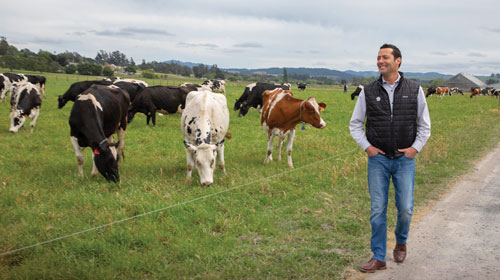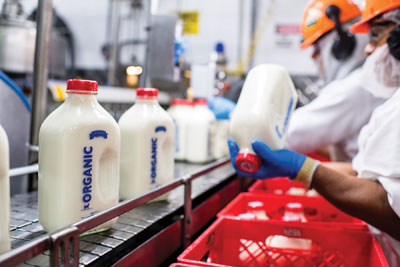
Cows grazing along hillsides and in seaside meadows are a picturesque and familiar sight in Marin and Sonoma counties. Dairy farms have been a local presence for more than 100 years, but these days, the picture behind the scenes is far from idyllic. In many areas across the United States, the dairy industry is in distress, and farms are facing challenges. Chief among them are low selling prices, competition from alternate-dairy products and consumer demand for non-dairy products made from plants.
On the farm
“Farms in California are in the same boat as farms everywhere in the country,” says Albert Straus, founder and chief executive officer of Straus Family Creamery in Marshall. He reports that nationwide, the United States has lost 30 percent of its dairies in the last decade. Dairy farms tend to be conventional in most parts of the country, but in the North Bay, they are mostly organic, which is a strength. “Over the last decade, we haven’t lost any farms,” says Straus, but he emphasizes that even organic farms are struggling, because sales are flat or declining. “Farmers need to pay themselves,” he says. But they’re unable to do so when the price they receive for milk is below production costs. Compounding the problem, when they don’t earn enough, they can’t invest in infrastructure or ensure succession to the next generation.
Marcus Benedetti, chairman and CEO of Clover Sonoma, which processes milk to create a variety of dairy products at its facility in Petaluma, has also observed the dilemma farmers are facing. “You have to look at the industry overall—conventional and organic milk. We’re about half and half,” he says. According to Benedetti, milk is the top agricultural commodity in the state, and most of it is conventional. The plight of conventional milk has been an issue for a long time because while costs for famers have gone up, the price they receive for their milk hasn’t.
“The margins have been significantly cramped over the years,” he says. Organic milk, however, is different, and it began to pay off in 1999 since increased demand meant processors could pay more for it than conventional milk. Sonoma County is especially suitable for organic production because it has lots of pasture and a marine climate, which is ideal because it prevents cows from overheating. Thus, local farmers made the transition to producing organic milk and adopted methods similar to those of 100 years ago. “It was like back to the future in many ways,” says Benedetti. The shift to organic gave Clover Sonoma the opportunity to market local farms to urban consumers. “It was a lifeline,” he says, because it allowed farms to become profitable again. The market for organic milk, however, eventually was oversupplied, and prices came crashing down. Now, many organic producers don’t have places to sell their milk and must settle for conventional prices. And that’s not sustainable.
 Straus Family Creamery processes organic milk from 2,650 cows that graze on 6,600 acres from 10 family farms, including the Straus Dairy Farm. Straus makes organic dairy products such as yogurt, ice cream, and butter. In addition, the company offers organic milk in reusable glass bottles. Under Albert Straus’ leadership, the company has a dual perspective as both a farmer and a processor. His farm is one of the 10 farms that supplies milk to the creamery. Straus collaborates with the other farmers to agree upon a specific volume and price. The relationship is mutually beneficial, and the strategy is designed to avoid overproduction, which depresses prices. “We work collaboratively with the farmers to control milk volume,” he explains. “When we have too much milk, we must sell it at a loss, and the loss is ultimately reflected in the farmers’ income.” he explains. The creamery pays the dairies twice a month, and instead of making automatic deposits or mailing checks, they deliver the checks by hand, so they can build relationships and knowledge about organic farming.
Straus Family Creamery processes organic milk from 2,650 cows that graze on 6,600 acres from 10 family farms, including the Straus Dairy Farm. Straus makes organic dairy products such as yogurt, ice cream, and butter. In addition, the company offers organic milk in reusable glass bottles. Under Albert Straus’ leadership, the company has a dual perspective as both a farmer and a processor. His farm is one of the 10 farms that supplies milk to the creamery. Straus collaborates with the other farmers to agree upon a specific volume and price. The relationship is mutually beneficial, and the strategy is designed to avoid overproduction, which depresses prices. “We work collaboratively with the farmers to control milk volume,” he explains. “When we have too much milk, we must sell it at a loss, and the loss is ultimately reflected in the farmers’ income.” he explains. The creamery pays the dairies twice a month, and instead of making automatic deposits or mailing checks, they deliver the checks by hand, so they can build relationships and knowledge about organic farming.
While the price of milk is a major factor in current difficulties, labor, housing and regulatory compliance are also contributors. Finding qualified people is a challenge, for example, because young people who would like to work in the dairy industry need an education that will teach them technical, agricultural and business skills. High schools and community colleges no longer have enough programs. “There used to be a whole pipeline of students who had technical skills,” says Straus. What’s more, they started working right out of junior college or high school. Now those opportunities are limited at that level. For those who are able to pursue upper education, Chico State University offers an organic dairy program. “I’ve hired two people from Chico for my own dairy farm,” says Straus.
“The lack of affordable housing in rural communities is creating a hardship for our creamery,” says Straus. Vacation homes and short-term rentals are replacing available housing for full-time residents and a local workforce. Housing costs are making it unaffordable for agricultural workers to live in our communities. For the last 25 years, the creamery has been located on a ranch near Marshall, but it’s in the process of building a new plant in Rohnert Park. It will be closer to where a vast majority of the employees live. 
What’s additionally daunting for farmers is a multitude of permits and reports, which further complicates their situation. Oversight, while necessary, requires farms to complete 30 to 40 forms and permits each year, a time-consuming and expensive process. As a result, “Farmers have a hard time concentrating on their businesses,” says Straus. Technology can offer more interactive data collection that agencies can streamline. “It shouldn’t be so onerous that farmers get frustrated,” he points out.
At the plant
Clover Sonoma began as the Petaluma Cooperative Creamery in 1916 to distribute Clover products to stores and residential customers. It became Clover Stornetta in 1977, and in 2017, it was rebranded as Clover Sonoma. “As a processor, we’ve invested heavily in our brand over the last 40 years,” says Benedetti. He explains that the Clover brand is synonymous with quality, and rather than being an abstract concept, it’s based on data, with looking at bacteria counts and ensuring that they don’t exceed certain thresholds as one of the measures. The company also requires its suppliers to be certified by the American Humane Association, guaranteeing that they treat animals humanely. Clover earned its B Corp certification in 2016, confirming its commitment to social responsibility and caring for the environment. “As a brand, we’ve been able to elicit a higher price in the marketplace,” he says. The profits are passed on to the farmers who supply their milk, because they’re the ones who give the company a competitive advantage.
Even so, processors have challenges. Employee retention is a concern, for example, because the cost of housing in the North Bay is so expensive. Clover Sonoma has 250 employees, and some of its drivers live as far away as Lake County. In addition, Sonoma County is a high-cost environment for manufacturing. “If I were a manufacturer of conventional products, it’s the last place I’d be,” says Benedetti, though he recognizes the importance of Sonoma County’s sense of place and how it adds value to a brand. It’s an idyllic place for dairy cows, he says, with ample sunshine, excellent air quality and a cool climate that allows cows to thrive. When combined with the farmers’ good management practices and the quality of the feed, Sonoma County produces the cleanest milk in the country. The area’s reputation for quality is a reason why Clover products sell well in a market like Southern California. “The farmers work hard at it,” he says. “People universally understand that Sonoma County is a place where all good things are produced,” he observes.
The dairy industry also faces the continued challenges of market and consumer shifts. “How do we stay relevant in an ever-shifting consumer landscape?” asks Benedetti. One answer is innovation and creating new dairy-based products that meet customer needs. An example is lactose-free milk, which Clover introduced last year for people who want the nutritional value of milk, but are lactose-intolerant. Organic omega 3 milk, a line of cultured products geared to kids and probiotics to aid digestion are new products under consideration. “That’s the next renaissance in meeting consumers’ needs,” he says. A new line of flavored butters is also in the works. They’re creative marketing solutions, but the growth of non-dairy alternatives is creating new competition as well, and dairy has ceded a lot of ground to alternatives. “Once upon a time, all Americans drank milk,” Benedetti observes. But that’s no longer true.
The plant-based trend
 Ted Robb, CEO of New Barn Organics, recognized the trend toward alternative products to dairy several years ago. “It was clear to me that customers at the grocery store were changing their purchasing habits.” He saw the opportunity to reach a new and growing market and launched the company in 2015 as New Barn. Later, he changed the name to New Barn Organics and moved its headquarters to Sonoma Mountain Village in Rohnert Park. He believed consumers were looking for better quality non-dairy alternatives and decided to produce an organic, homemade-style almond milk, rather than a conventional one with artificial gums and flavors. It caught on quickly and began distribution nationally within three months. He reports that the growth in plant-based foods was about 8 percent in 2017 and grew to 20 percent in 2018. “We picked the right time, the right place and the right category,” he says.
Ted Robb, CEO of New Barn Organics, recognized the trend toward alternative products to dairy several years ago. “It was clear to me that customers at the grocery store were changing their purchasing habits.” He saw the opportunity to reach a new and growing market and launched the company in 2015 as New Barn. Later, he changed the name to New Barn Organics and moved its headquarters to Sonoma Mountain Village in Rohnert Park. He believed consumers were looking for better quality non-dairy alternatives and decided to produce an organic, homemade-style almond milk, rather than a conventional one with artificial gums and flavors. It caught on quickly and began distribution nationally within three months. He reports that the growth in plant-based foods was about 8 percent in 2017 and grew to 20 percent in 2018. “We picked the right time, the right place and the right category,” he says.
“We use the fewest, cleanest, simplest organic ingredients. Our products are all pretty simple,” says Robb. Unsweetened Almond milk is the top seller, and it’s made of organic, non-GMO almonds from the Valencia region of Spain, because most California-grown almonds are not organic. It also contains filtered water, organic acacia gum and sea salt. Almond milk needs an emulsifier; otherwise, it will separate during the shipping process and won’t come together again. Acacia gum—which comes from the sap of the acacia tree and is sold as a supplement in health food stores—was a simple, food-based product to meet that need. Almond milks and a non-dairy dessert comprise the product line, along with organic almond dips, creamers, single-serve coffee and a buttery spread, which became available in the marketplace this summer.
Robb believes that although vegans are among New Barn Organics’ customers, many more people are looking for alternatives to replace certain parts of their diet. That doesn’t necessarily mean rejecting dairy products. “We’re not trying to go against dairy. We feel the customer is going to eat along the spectrum,” he says, and New Barn Organics is providing options for people who want both. Whether it’s an alternative or dairy, people are looking for simple, organic foods from companies that are transparent about their practices that they can eat every day and feel good about.
Innovation and vision
In late 2018, the Sonoma Economic Development Board released a draft Agro-Economy Industry Report on Farming in Sonoma County. Its recommendations for dairy included exploring the creation of an agricultural business council to connect and examine different efforts, such as launching a buy-local campaign and further encouraging value-added products. Executive Director Ben Stone reports that the EDB has sent a draft proposal to agriculture groups for comment and also suggests exploring creation of a strategic plan for agriculture.
“When I first came to the county in 1986, dairy was the biggest thing,” says Stone. “As the second largest ‘crop,’ dairy has substantial benefits for the county nonetheless. First, it supplies consumers with locally-produced milk and provides jobs, and second, it plays an important role in the tourism industry. “The No. 1 reason they come the first time is wine,” says Stone, but they return for the bucolic beauty. “People love seeing the cows,” he says. He adds that visitors enjoy farm visits, as well as attractions such as the Cheese Trail.
“The Cheese Trail is an important reason people visit Sonoma County, and it elevates our destination,” says Tina Luster, of Sonoma County Tourism. “Our Sonoma County social media love all things cheese, as evident from our engagement during Artisan Cheese Festival.” She reports that Sierra Downey, SCT’s social media coordinator, compiled social media posts related to the festival, which took place in March, and found that it had 2,502 views on Instragram, reached 14,500 people on Facebook and had 2,119 Twitter impressions. Holy cow!
Anecdotal reports also show the Cheese Trail’s success. Vivien Straus created cheesetrail.org, which includes the California Cheese Trail map, and received positive comments from cheesemakers after its launch. For example, she says, “Within two months of the first map being printed, Marin French Cheese told me their retail sales increased 25 percent. That was in 2011; I’m sure it’s had an even greater impact since.”
Though the dairy industry might be hurting, the North Bay is traditionally a place for visionaries, and when people work together, it makes a difference. Benedetti explains that when his grandfather, Gene Benedetti, started Petaluma Cooperative Creamery more than 100 years ago, he took a novel approach to business, based on his belief that one can’t be successful in the community unless others are successful as well. “It’s as important today as it was two generations ago,” he says. “Growth and scale is a great thing because you can increase your giving and bring on more farms.” He believes dairy farms must have a relationship with a local, branded company. Otherwise, their future will be hazardous. Straus also believes the dairy industry will continue to grow, though it’s likely to be challenging.
His mission is to revitalize and sustain family farms while producing great-tasting organic dairy products, and the best way to do that is by building a model that’s sustainable for the planet. This model takes animal welfare into consideration and cares for the people who live and work in the community. The ultimate goal is a more localized food system that’s proactive and creates high-quality food. “We can build a food system that will lead not only to sustainable farms, but will be a model for the country and the world,” he says. “We can do this if we share a common vision, work together and build trust and respect in our community. “ It’s a laudable ambition, and with innovative leaders taking the initiative, the North Bay dairies could well be primed for a strong future.
clo turns 50
 Clover Sonoma’s iconic cow, Clo, made her first appearance as the company’s mascot in 1969, and she’s been making people smile at her clever puns on local billboards ever since. “Clo is pretty timeless,” says CEO Marcus Benedetti. “She’s consistently lighthearted and uncontroversial.”
Clover Sonoma’s iconic cow, Clo, made her first appearance as the company’s mascot in 1969, and she’s been making people smile at her clever puns on local billboards ever since. “Clo is pretty timeless,” says CEO Marcus Benedetti. “She’s consistently lighthearted and uncontroversial.”
Her challenge is to maintain relevance over time, and her puns have successfully evolved with the generations. Her most popular line, “Tip Clo through your two lips,” even resonates with those too young to be familiar with its origin, a song by Tiny Tim in the 1960s. Among the highlights of Clo’s milestone year, she had a two-month show at the Petaluma History Museum, Clo at the Mooseum: 50 Years Young, and was Grand Marshall at the 38th annual Petaluma Butter & Eggs Day Parade in April.
farm tours
Pack up the kids and take a drive to the country! Families can learn about dairy farming firsthand and see cows up close on a traditional farm tour at McClelland’s Dairy Farm in Petaluma. Among the activities, they can pet baby calves, see the pastures where cows graze, visit the milking parlor to see a cow being milked and maybe even milk a cow the old-fashioned way—by hand. Reservations are required. For more information, visit mcclellandsdairy.com.
inspections
Dairy farms in Marin County: 23
Dairy farms in Sonoma County: 69
Average number of milk cows: 330
Number of cows at largest dairy: 1,100
Number of cows at smallest dairy: 110
Dairies in Marin and Sonoma counties undergo inspections twice a year. Inspectors check for sight and odor, bacterial limits, somatic cell count (which indicates the presence of infection in a milk cow), the presence of antibiotics, cooling temperature and sediments. Dairy farms also undergo inspections to make sure they comply with water standards and proper construction and maintenance for milking barns and rooms.
To receive a Grade A classification, a dairy must have twice-yearly inspections, while those with a Grade B classification are inspected once a year. A Grade A producer’s facilities and milk have to meet more stringent health and sanitation requirements. In California, most milk products are made with Grade A dairy. Processors can use Grade B milk for butter, cheese and ice cream.
Most dairy farms in Marin and Sonoma counties are organic. If their gross annual sales of organic products exceed $5,000, they must be third-party certificated, which allows them to use the USDA Organic seal.
Source: University of California Cooperative Extension
Sonoma County’s Dairy Industry
California is the No. 1 milk-producing state in the nation, providing 18 percent of U.S. milk, according to statistics compiled by the Sonoma Economic Development Board. Here are a few more facts about the Sonoma County’s dairy industry.
Number of Dairies: 62
Number of Cows: 30,051
Total Milk Production: 478,273,112 lbs.
Value of fresh milk produced in 2017: $137 million




